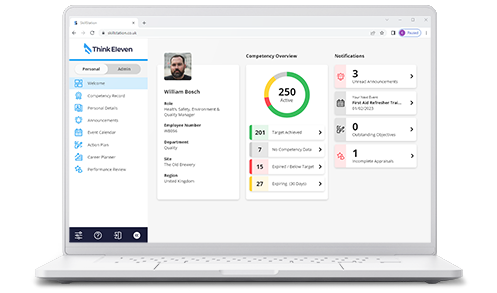As political, economic, societal, and technological factors begin affecting industries of all sectors (more rapidly than ever), the skills required within the workforce rapidly change too. In this article we will clarify the difference between upskilling and reskilling, as well as how we can identify and address the skills gaps created.
40% of workforce core skills will change by 2025 (source - World Economic Forum). As political, economic, societal, and technological factors begin affecting industries of all sectors (more rapidly than ever), the skills required within the workforce rapidly change too.
For example, the rise of digitalisation and automation has seen the requirement of a re-skilled workforce to effectively adapt. The move to renewable energy production sees the need for a re-skilled workforce to make the transition away from fossil fuels as smooth as possible.
This undoubtedly creates skills gaps that managers, leaders and employers need to be able to effectively identify and resolve as quickly as possible.
In this article we will clarify the difference between up-skilling and re-skilling, as well as how we can identify and address the emerging skills gaps.
What is the difference between re-skilling and up-skilling?
Whilst the terms are similar, there’s a subtle difference as outlined in the examples below.
Re-skilling
Involves the replacement of existing skills/capabilities that are no longer relevant. For example, an in-store salesperson being re-skilled as customer service agent to prepare for the shift from brick-and-mortar to online e-commerce.
Up-skilling
Involves the acquisition of higher level skills that are relevant and complementary to an existing skill-set. For example, this could be giving in-house (classroom) trainers who typically use MS PowerPoint the skills to author eLearning, to support the need for remote working.
Is up-skilling and re-skilling important?
In a report published by World Economic Forum called The Future of Jobs Report 2020 it is estimated that 40% of workforce core skills will change by 2025. This means that over the next five years (and beyond) the skills gaps within the workforce will be widening. As a result, operational capability will become less agile, efficient, and ultimately less profitable.
What is a skills gap?
A skills gap is the difference between skills required to perform a role / task and the skills the employee must have to fulfill that role / task.
The causes of skills gaps occur both inside and outside the organisation. For example, slow moving education systems struggle to keep pace with technological development, resulting in graduates leaving with outdated skills. Another example could be an employer looking to fill a vacancy with an experienced employee when the role may be breaking new ground, making the skills scarce in the talent pool.
An aging workforce may also exacerbate the issue, with older generations retiring and taking their knowledge, skills and experience with them, so younger generations do not have the opportunity to learn from them (knowledge transfer).
What is the solution?
The solution is a systematic programme of re-skilling and up-skilling the workforce. The best way to deploy this in an effective, efficient, and targeted approach, using a competency management system with training needs analysis, gap analysis and succession planning.
The next step...
With the acceleration of digitalisation, robotification and automation, the workforce skills gap will only become more important for organisations to tackle with appropriate strategies for up-skilling and re-skilling.
Some first steps to take are:
- Scenario planning i.e. looking to the future to establish what changes might affect your organisation's ability to perform and compete in your market.
- Gap analysis of your current capabilities in comparison to future need.
- Structured and focused training & development programmes.
- Identify opportunities for staff to become multidisciplinary practitioners to increase workforce versatility and adaptability.
- Mentorship schemes to support employees through the change programme.
- Knowledge transfer systems to ensure expertise is identified and successfully passed on in a structured way.
There is an easy way!
We’ve got one more step that makes the whole problem much easier to manage:
- Mapping skills to job profiles within a competency management system (CMS).
- Using standardised and non-subjective approaches to assess proficiency.
- Proactive training needs analysis and succession planning.
Using a competency management system such as SkillStation allows managers and leaders to understand the required skills associated with individual roles. Using a skills matrix report makes it easy to pinpoint the skills gaps and deliver training in a very focused way.
If you would like to know more about how to tackle up-skilling, re-skilling, or using a skills matrix to perform gap analysis, then get in touch! Our friendly team of experts are always happy to help!




